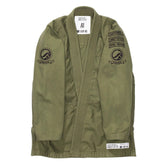Shoulder Strengthening for BJJ: Best Exercises to Train & Prevent Injury
In the world of Brazilian Jiu Jitsu (BJJ), strength, mobility, and injury prevention go hand-in-hand. It is true especially when it comes to your shoulders. It does not matter whether you are a beginner in Gi BJJ classes or a seasoned No-Gi BJJ athlete competing at a high level. Shoulder strength plays a vital role in performance and longevity on the mats.
Shoulders are involved in nearly every BJJ movement i.e. framing, posting, gripping, shrimping or defending submissions. Without a well-conditioned shoulder joint and surrounding musculature, you limit your ability to perform effectively. Moreover, it also opens the door to injuries like rotator cuff tears, impingement and dislocations.
In this comprehensive guide, we will explore why shoulder strengthening is essential for BJJ practitioners. Besides, we will break down the best exercises you can implement right now to boost performance, increase shoulder resilience and prevent common BJJ injuries.
Looking for? Best Home Workouts for BJJ Strength and Conditioning
Why Shoulder Strengthening Is Critical for BJJ Athletes
1- High Demands on the Shoulder Joint in BJJ
In Brazilian Jiu Jitsu, the shoulder is one of the most overworked joints. It is due to the dynamic and unpredictable nature of grappling. In both Gi and No-Gi BJJ, the shoulder must constantly shift between explosive force and isometric tension, whether you are defending an omoplata, shooting for an underhook or bracing a guard pass.
Unlike other sports, BJJ practitioners often find themselves in awkward, unbalanced or compromised positions. Thus, making shoulder stability a top priority.
2- Injury Prevention
Shoulder injuries in BJJ are more common than many athletes realize. The rotator cuff, labrum and AC joint are frequent victims of submissions (like the Kimura or Americana), overtraining or poor posture. A targeted shoulder strengthening routine can reinforce these structures. Ultimately, it protects shoulders against chronic and acute injuries.
3- Performance Enhancement
Strong shoulders improve grip fighting, guard retention, scrambles and submissions. A more powerful and stable upper body gives you a clear edge in BJJ Gi competitions where grips matter, and in No-Gi BJJ where frames and pummeling are everything.
Key Components of an Effective BJJ Shoulder Training Program
To train smart and prevent injury, your shoulder-strengthening program should include:
- Mobility and stability work
- Rotator cuff isolation exercises
- Scapular retraction and control
- Dynamic shoulder strengthening
- Prehab/rehab movement patterns
Let’s dive into the most effective exercises for each of these components.
Best Shoulder Strengthening Exercises for BJJ
1- Scapular Wall Slides
Purpose: Improves shoulder mobility and scapular control
How to Do It:
- Stand against a wall with your back, head and glutes touching.
- Raise your arms to a "goalpost" position and slowly slide them up and down against the wall.
- Focus on keeping contact with the wall throughout the movement.
Reps: 3 sets of 10 reps
Why It’s BJJ-Specific: Promotes scapular function which is crucial for maintaining posture and shoulder health during extended rolling sessions.
2- External Rotations with Resistance Bands
Purpose: Strengthens the rotator cuff, especially the infraspinatus and teres minor.
How to Do It:
- Attach a resistance band to a fixed point.
- Stand sideways, elbow bent at 90°, and rotate the arm outward against the band.
Reps: 3 sets of 15 reps per arm
Why It’s BJJ-Specific: Prevents shoulder instability and helps resist submissions like the Kimura.
3- Face Pulls
Purpose: Targets rear delts and improves posture
How to Do It:
- Use a cable machine or resistance bands.
- Pull towards your face while keeping elbows high and squeezing your shoulder blades.
Reps: 3 sets of 12–15 reps
Why It’s BJJ-Specific: Great for undoing forward shoulder posture caused by excessive guard work or grip fighting.
4- Kettlebell Arm Bars
Purpose: Enhances shoulder stability under load
How to Do It:
- Lie on your back with a kettlebell extended overhead.
- Slowly rotate your body away from the kettlebell while keeping it stable.
Reps: 3 sets of 5 reps per side
Why It’s BJJ-Specific: Mimics the stabilization needed during armbar escapes or side control retention.
5- Overhead Carries
Purpose: Builds shoulder endurance and core stability
How to Do It:
- Hold a dumbbell or kettlebell overhead.
- Walk in a straight line maintaining a neutral spine and engaged core.
Reps: 2-3 rounds of 30–60 seconds
Why It’s BJJ-Specific: Conditions your shoulders for long rounds, especially when holding top control or maintaining frames.
6- I-Y-T Raises
Purpose: Strengthens mid and lower traps, improving scapular retraction
How to Do It:
- Lie face-down on an incline bench or use a Swiss ball.
- Raise your arms in I, Y, and T shapes with light dumbbells or bodyweight.
Reps: 2 sets of 10 reps each
Why It’s BJJ-Specific: Enhances posture and shoulder stability. Hence, key for injury prevention in both Gi and No-Gi BJJ.
7- Push-Up Plus
Purpose: Strengthens the serratus anterior for shoulder blade stability
How to Do It:
- Perform a standard push-up, then push further at the top to protract your scapula.
Reps: 3 sets of 10-15
Why It’s BJJ-Specific: Improves shoulder health during framing and pummeling exchanges.
Recovery and Prehab for Long-Term Shoulder Health
In addition to strengthening, recovery and prehab exercises should be part of every BJJ athlete's routine. These include:
- Foam rolling the thoracic spine to relieve upper back tension
- Band pull-aparts to warm up posterior shoulder muscles
- Sleeper stretches for internal rotation mobility
- Shoulder dislocates with a PVC pipe or resistance band
Use these movements as part of your warm-up before BJJ class or your cool-down routine after rolling.
Gi vs. No-Gi BJJ: Shoulder Demands Comparison
Understanding how Gi BJJ and No-Gi BJJ affect shoulder use can further help you fine-tune your training.
In Gi BJJ:
- Gripping is constant, placing more stress on the rotator cuff and forearm.
- Postural endurance is critical due to prolonged grip engagements.
- Strong shoulders help you resist grip breaks and maintain lapel control.
In No-Gi BJJ:
- Shoulder mobility and explosiveness are emphasized.
- Fast scrambles, pummeling, and underhook battles demand dynamic shoulder function.
- Stability under motion is key due to the slippery nature of No-Gi training.
By tailoring your shoulder training to match your preferred style (or balancing both), you will boost your mat performance significantly.
How Often Should You Train Shoulders for BJJ?
For optimal results:
- 2-3x per week, alternating focus between mobility, strength and stability
- Avoid training shoulders to failure before a hard rolling session
- Prioritize quality over quantity—proper form matters more than heavy weights
Final Thoughts: Stay Strong, Stay on the Mats
Shoulder injuries can sideline your progress in BJJ faster than almost any other joint issue. But with a consistent, targeted shoulder strengthening program, you will build the resilience. And this resilience is needed for high-level Brazilian Jiu Jitsu performance in both Gi and No-Gi settings.
It does not matter if you are a beginner learning the fundamentals or a competitor aiming for gold. Protecting and developing your shoulders will directly translate into better performance, more confidence and fewer injuries on the mat.
So, add these exercises to your weekly routine and give your shoulders the attention they deserve. Because strong shoulders keep you rolling longer!
Looking to take your BJJ gear and training to the next level? Explore our premium BJJ Gi collections, compression wear and No-Gi rash guards at Novakik BJJ. These are all engineered for durability, performance and comfort.


















